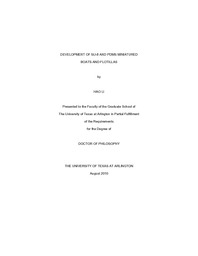| dc.description.abstract | In this work, we developed miniaturized SU-8 and PDMS miniaturized boats and flotillas, and explored their designs, fabrication, actuation, motions and driving mechanisms. Like large-scale boats and flotillas, these miniaturized boat and flotillas can be potentially applied to transport designed targets to desired locations in small fluidic systems. They may also be employed as mixers, rotators and so on. We first develop a SU-8 boat, and studied its design, fabrication, actuation and motions. In three types of tests conducted on water free surfaces of different heights in a 30-cm-long channel, the microboat had a speed in the order of 0.1 m/s, and propulsive forces ranged from 159 to 250 μN. It took 1 to 2 s for the microboat to go through the channel, and resistance coefficients varied from 0.144 to 0.324. Also, when the resistance coefficient was 0.324, the microboat was still able to travel a distance of 91.4 cm within 5.33 s. We then initiated the effort of developing miniaturized SU-8 and PDMS flotillas, which were capable of moving on a water surface. We explored their designs, fabrication, propulsion, and motions in straight and circular channels. The SU-8 flotilla comprised five miniaturized SU-8 boats connected with a Nylon rope, and was fabricated using ultra-violet lithographic techniques. The PDMS flotilla comprised five miniaturized PDMS boats connected with PDMS lines, and was fabricated using molding techniques. Both types of flotillas were actuated due to the difference between fore-and-aft surface tensions. The SU-8 flotilla was tested in three straight and one circular channels at water levels of 3 mm, 6 mm and 9 mm, respectively. In all the tests, the flotilla moved like a rigid object, and no collisions were observed between neighboring boats. Travel distances were above 0.44 m, and average speeds varied from 40.2 mm/s to 103.2 mm/s. Both the travel distances and the average speeds were found to increase with the increasing water depth and channel width. The two ends of the microtrain had direct contact with the outer sidewall of the circular channel during a circular motion. The support forces of the outer sidewall at these contact points provided the centripetal force needed for the circular motion. The same tests were conducted for the PDMS flotilla, and the corresponding testing results were similar to those of the SU-8 flotilla. Compared with a single boat, such a flotilla can be potentially employed to transport a large amount of supply in small fluidic applications. Finally, we explored the driving mechanisms of the developed boats and flotillas. A floating solid fragment may have a spontaneous motion on a water surface when a liquid, which has a surface tension lower than water, exits the solid fragment and has contact with water. This motion may be induced due to the surface tension difference between water and the liquid. In order to interpret this motion, it is important to know how the liquid exits the solid fragment. We reported in-situ observation of exchange processes of water and isopropyl alcohol (boat propellant) inside both close and open reservoirs of cm-scaled PDMS boats. Based on this observation and force analysis, we interpreted driving mechanisms of these boats. We found that the exchange processes may be different in the PDMS boats of respective close and open reservoirs. The PDMS boat of a close reservoir may have a bubble trapped in its reservoir. This bubble slowed down the exiting process of the IPA from the reservoir, made the motion last longer, and enabled the boat to have a longer travel distance. Also, such a boat might have gurgling-like motions (i.e., approximately periodic motions of speeding up and slowing down) after the majority of the isopropyl alcohol had exited the reservoir. On the other hand, neither bubbles and nor gurgling-like phenomena were found during the motions of the PDMS boat with an open reservoir. Financial support for this project was provided by the University of Texas, Arlington, and NSF Grant NSF-ECS-0529104. | en_US |


